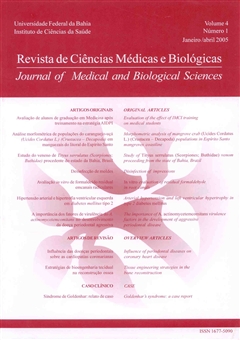The importance of A. actinomycetemcomitans virulence factors in the development of aggressive periodontal disease
DOI:
https://doi.org/10.9771/cmbio.v4i1.4176Keywords:
virulence factors, A. actinomycetemcomitans, periodontal disease.Abstract
The periodontal disease is characterized by morphological changes in the supporting structures of the teeth and is caused by an interaction of bacterial subgroups and a susceptible subject. This interaction is necessary because the presence of periodontal pathogens can be frequently detected in healthy subjects. This indicates that not all subjects are equally susceptible and/or that there is a variation in virulence and potential pathogens. It is frequently believed that Gram-negative bacteria are involved in the initiation of inflammatory periodontal disease. One of the major microorganisms implicated in some forms of periodontal disease is Actinobacillus actinomycetemcomitans. Though the exact mechanism of the pathogenicity of A. actinomycetemcomitans is not clear, a number of virulence factors have been characterized. These factors include: adhesion and invasion of epithelial cells, lipopolysaccharide, fibroblast-inhibitory factor, leukotoxin and polymorphonuclear leukocyte chemotaxis inhibitory factor.Downloads
Download data is not yet available.
Downloads
Published
2005-07-06
How to Cite
Campos, V. B. de S., & Figueredo, C. M. (2005). The importance of A. actinomycetemcomitans virulence factors in the development of aggressive periodontal disease. Journal of Medical and Biological Sciences, 4(1), 54–62. https://doi.org/10.9771/cmbio.v4i1.4176
Issue
Section
ORIGINAL ARTICLES
License
The Journal of Medical and Biological Sciences reserves all copyrights of published works, including translations, allowing, however, their subsequent reproduction as transcription, with proper citation of source, through the Creative Commons license. The periodical has free and free access.


